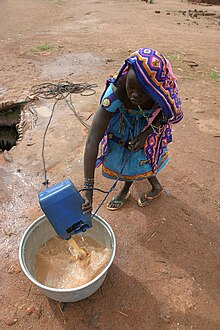User:A.pink236/Waterborne diseases
Updates to the lead:
[edit]One of the earliest understandings of waterborne diseases in Europe arose during the 19th century, when the Industrial Revolution took over Europe.[1][2] Waterborne diseases, such as cholera, were once justified by the miasma theory, the theory that bad air causes the spread of diseases.[1][3] However, people started to find a correlation between water quality and waterborne diseases, which led to different water-purification methods, such as sand filtering and chlorinating their drinking water.[1]
Surveillance
[edit]WBDOSS and the public health community work together to look into the causes of contaminated water leading to waterborne disease outbreaks and maintaining those outbreaks. They do so by having the public health community investigating the outbreaks and WBDOSS receiving the reports.
- ^ a b c Juuti, Petri S.; Katko, Tapio; Vuorinen, H. (2007-02-01). Environmental History of Water. IWA Publishing. ISBN 978-1-84339-110-4.
- ^ "ESSAI | College Publications | College of DuPage". dc.cod.edu. Retrieved 2020-11-24.
- ^ "ESSAI | College Publications | College of DuPage". dc.cod.edu. Retrieved 2020-11-23.
History of Waterborne Disease
[edit]Britain
[edit]The 19th century was a time of industrialization as the Second Industrial Revolution took over Europe.[1] Britain was the center for urbanization during this time period, and as a result of the rapid nature of industrialization, many health and sanitation problems manifested, resulting in Britain playing a large role in the development for public health.[2] Before discovering the link between unsanitary water and diseases, such as cholera and other waterborne diseases, the miasma theory was used to justify the outbreaks of these illnesses.[2] Miasma theory is the theory that certain diseases and illnesses are the products of miasma or bad air quality.[3]

Edwin Chadwick, in particular, played a key role in Britain's sanitation movement, using the miasma theory to back up his plans for improving the sanitation situation in Britain.[2] Although Chadwick brought contributions to developing public health in the 19th century, it was John Snow and William Budd who introduced the idea that cholera was the consequence of contaminated water, presenting the idea that diseases could be transmitted through drinking water.[2]
People found that purifying and filtering their water improved the water quality and limited the cases of waterborne diseases.[2] A town called Altona was the first to illustrate this finding as they used a sand filtering system for their water.[2] A nearby town that didn't use any filtering system for their water suffered from the outbreak while Altona remained unaffected by the disease, providing evidence that the quality of water had something to do with the diseases.[2] After this discovery, Britain and the rest of Europe took into account to filter their drinking water, as well as chlorinating them to fight off waterborne diseases like cholera.[2]
In India where people experience the huge contrast in water availability and scarcity. There are places that have an abundance of water and others where water is the main concerning issue and women's daily job consists of sourcing water for their household. Places with adequate water supplies struggle to sustainably manage the use of it while others struggle with the reality of scarce clean drinking water. Underlying this imbalance in water availability is the issue of water-borne diseases.
Towns and cities with an abundance of water struggle to manage the water efficiently, often leading to water collecting in potholes and or in the surrounding areas and going unused. This can have severe consequences as water-borne diseases, such as cholera, malaria and diarrhea can spread as a result of improper management of the water supply as well as discharge. The Ganges provide water to over 500 million Indians - contamination of just one source of water could affect millions of lives in one go. Water contamination often occurs due to inadequate and incompetent management of resources as well as inflow of sewage into the source.
In India, over one lakh people die of water-borne diseases annually. It is reported that groundwater in one-third of India’s 600 districts is not fit for drinking as the concentration of fluoride, iron, salinity and arsenic exceeds the tolerance levels. About 65 million people have been suffering from fluorosis, a crippling disease due to a high amount of fluoride, and five million are suffering from arsenicosis in West Bengal due to high amount of arsenic. A World Resources Report says: about 70 per cent of India’s water supply is seriously polluted with sewage effluents. The UN reported that India’s water quality is poor - it ranks 120th among 122 nations in terms of quality of water available to its citizens.
Viruses[edit]
[edit]
| Disease and transmission | Viral agent | Sources of agent in water supply | General symptoms |
|---|---|---|---|
| Hepatitis A | Hepatitis A virus (HAV) | Can manifest itself in water (and food) | Symptoms are only acute (no chronic stage to the virus) and include Fatigue, fever, malaise[5], abdominal pain, nausea, diarrhea, weight loss, itching, jaundice, and depression. |
| Hepatitis E (fecal-oral) | Hepatitis E virus (HEV) | Enters water through the feces of infected individuals | Symptoms of acute hepatitis (liver disease), including fever, fatigue, loss of appetite, nausea, vomiting, abdominal pain, jaundice, dark urine, clay-colored stool, and joint pain |
| Acute gastrointestinal illness [AGI] (fecal-oral; spread by food, water, person-to-person, and fomites) | Norovirus | Enters water through the feces of infected individuals | Diarrhea, vomiting, nausea, stomach pain |
| Poliomyelitis (Polio) | Poliovirus | Enters water through the feces of infected individuals | 90-95% of patients show no symptoms, 4-8% have minor symptoms (comparatively) with delirium, headache, fever, and occasional seizures, and spastic paralysis, 1% have symptoms of non-paralytic aseptic meningitis. The rest have serious symptoms resulting in paralysis or death |
| Polyomavirus infection | Two of Polyomavirus: JC virus and BK virus | Very widespread, can manifest itself in water, ~80% of the population has antibodies to Polyomavirus | BK virus produces a mild respiratory infection and can infect the kidneys of immunosuppressed transplant patients. JC virus infects the respiratory system, kidneys or can cause progressive multifocal leukoencephalopathy in the brain (which is fatal). |
Socioeconomic Impact
[edit]
On the other hand the economic level of a community impacts their ability to have access to filtered water. [6] There are South Asian communities that do not have the economic stability to provide clean water and sewage.[7] Lower income correlates to families spending less money on water supply. [7] Socio-economics correlates to less education, which correlates to less knowledge on waterborne diseases.[7] Less developed areas such as Saggian do not have an existing or sufficient pipe to supply water or sewerage system.[7] Less developed countries might be more at risk for potential outbreaks of waterborne diseases but more developed regions also are at risk to waterborne disease outbreaks.[8] Water supply coming from private owned water supplies has a higher probability of a disease such as gastroenteritis spreading than a public (government regulated) water supply.[8]
- ^ Schnabel B. "Drastic consequences of diarrhoeal disease". Archived from the original on 2015-09-23.
- ^ a b c d e f g h Adelodun, Bashir; Ajibade, Fidelis Odedishemi; Ighalo, Joshua O.; Odey, Golden; Ibrahim, Rahmat Gbemisola; Kareem, Kola Yusuff; Bakare, Hashim Olalekan; Tiamiyu, Abdulgafar Olatunji; Ajibade, Temitope F.; Abdulkadir, Taofeeq Sholagberu; Adeniran, Kamoru Akanni; Choi, Kyung Sook (2021-01-01). "Assessment of socioeconomic inequality based on virus-contaminated water usage in developing countries: A review". Environmental Research. 192: 110309. doi:10.1016/j.envres.2020.110309. ISSN 0013-9351. PMC 7546968. PMID 33045227.
- ^ Malik, A; Yasar, A; Tabinda, AB; Abubakar, M (2012-06-30). "Water-Borne Diseases, Cost of Illness and Willingness to Pay for Diseases Interventions in Rural Communities of Developing Countries". Iranian Journal of Public Health. 41 (6): 39–49. ISSN 2251-6085. PMC 3469006. PMID 23113192.
- ^ "Water-Borne Diseases in India | Health". RESET.to. Retrieved 2020-11-22.
- ^ "Hepatitis A". www.who.int. Retrieved 2020-11-22.
- ^ Adelodun, Bashir; Ajibade, Fidelis Odedishemi; Ighalo, Joshua O.; Odey, Golden; Ibrahim, Rahmat Gbemisola; Kareem, Kola Yusuff; Bakare, Hashim Olalekan; Tiamiyu, Abdulgafar Olatunji; Ajibade, Temitope F.; Abdulkadir, Taofeeq Sholagberu; Adeniran, Kamoru Akanni; Choi, Kyung Sook (2021-01-01). "Assessment of socioeconomic inequality based on virus-contaminated water usage in developing countries: A review". Environmental Research. 192: 110309. doi:10.1016/j.envres.2020.110309. ISSN 0013-9351. PMC 7546968. PMID 33045227.
- ^ a b c d Malik, A; Yasar, A; Tabinda, AB; Abubakar, M (2012-06-30). "Water-Borne Diseases, Cost of Illness and Willingness to Pay for Diseases Interventions in Rural Communities of Developing Countries". Iranian Journal of Public Health. 41 (6): 39–49. ISSN 2251-6085. PMC 3469006. PMID 23113192.
- ^ a b Smith, A.; Reacher, M.; Smerdon, W.; Adak, G. K.; Nichols, G.; Chalmers, R. M. (2006/12). "Outbreaks of waterborne infectious intestinal disease in England and Wales, 1992–2003". Epidemiology & Infection. 134 (6): 1141–1149. doi:10.1017/S0950268806006406. ISSN 1469-4409.
{{cite journal}}: Check date values in:|date=(help)
